2021 Annual Report for: Gracillariidae / Lithocolletinae
For species seen in 2021 that had less than or equal to 100 records, full details are included; for more common species, the earliest, latest and highest count by vice-county are shown. The narrative for each species is taken from the main Hantsmoths website, and it is possible that some information on abundance and occurrence can get out of date, as it is impossible to keep up with all changes; however it should give a good introduction to each species. The tables in each species account summarise the previous status, and that for the current year.
For the maps, all records prior to 2021 are shown by a blue dot (the larger the dot, the more recent), with the current year's records shown in red. As previous records are superimposed on any report for 2021, new sites have greater emphasis (i.e. will show as 'more red').
In the species accounts, an asterisk next to a location indicates a new 10km square record; earliest ever dates are highlighted in orange, and latest ever in red. Initials in the species accounts refer to the recorders listed here. Please get in touch if you identify any omissions or errors, in particular if you have records that have yet to be submitted. Details of how to submit records can be found here.
15.034 [B&F: 0315] Phyllonorycter harrisella (Linnaeus, 1761) - Common
Common in oak woodland and areas with scattered oaks throughout Britain, widespread but apparently less frequent in Ireland. In Hampshire and on the Isle of Wight widespread and common. Wingspan 7-9 mm. Imago fairly regular at light, but more frequently recorded in the larval stage, when mines are relatively easy to find where they are present. Larva mines leaves of deciduous oaks Quercus, over-wintering as a pupa in a cocoon.
Records prior to 2021
| Vice County | #Records | #Individuals | First Record | Last Record |
|---|---|---|---|---|
| 10 | 52 | 44 | 1977 | 2020 |
| 11 | 275 | 197 | 1975 | 2020 |
| 12 | 119 | 222 | 1971 | 2020 |
2021 records
| Vice County | #Records | #Individuals | Max Quantity |
|---|---|---|---|
| 11 | 4 | 5 | 2 |
| 12 | 2 | 3 | 2 |
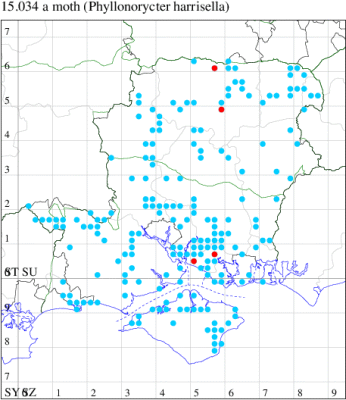
Records by year
Records by week (adult)
Records by week (larval)
Record Details
VC11: Chilling, two, field observation, 18 May (DPH); Fareham, one, 10 Aug; one, 18 Sep; one, 06 Oct (MLO);
VC12: Kempshott, one, 30 Jul (GAH); Axmansford, two, 02 Jun (ACB)
15.036 [B&F: 0317] Phyllonorycter heegeriella (Zeller, 1846) - Common
Common in oak woodland and areas with scattered oak trees throughout England, Wales and Scotland, except in the far north; commonest in southern England but rare in Ireland. Although not recorded in Hampshire until 1976, it is now widespread; first recorded on the Isle of Wight in 2005. Wingspan 6.5-7.5 mm. Similar to P. tenerella, which lacks the distinctly dark-bordered basal streak, although it occasionally has an ochreous base to the wing with a white central streak extending through this coloration (MBGBI Vol 2). Imago fairly regular at light, but more frequently recorded in the larval stage, when mines are relatively easy to find where they are present. Larva mines leaves of deciduous oak Quercus, over-wintering as a pupa in a cocoon.
Records prior to 2021
| Vice County | #Records | #Individuals | First Record | Last Record |
|---|---|---|---|---|
| 10 | 10 | 4 | 2005 | 2017 |
| 11 | 94 | 30 | 1972 | 2017 |
| 12 | 63 | 17 | 1971 | 2020 |
2021 records
| Vice County | #Records | #Individuals | Max Quantity |
|---|---|---|---|
| 11 | 2 | 1 | 1 |
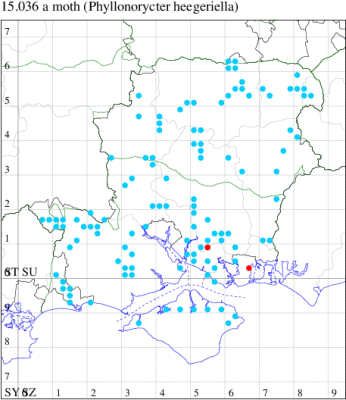
Records by year
Records by week (adult)
Records by week (larval)
Record Details
VC11: Botley Wood, one, 13 Aug (MLO, ADT, DWal, KJW det. RJD); Great Salterns NR, Portsmouth, mine, present, 30 Sep (MRY, JRL)
15.037 [B&F: 0318] Phyllonorycter tenerella (Joannis, 1915) - Local
Local in woodland throughout much of south-eastern England, found elsewhere as an introduction in Hornbeam plantations. In Hampshire apart from one old record from Alice Holt in 1963, recorded only since 1998, mostly by Rob Edmunds around Fleet, but also near Bentley and Odiham in north Hampshire and at Lower Test Marsh in south Hampshire. Recorded on the Isle of Wight for the first time at Osborne in 2010. Wingspan 6-8 mm. Imago may come to light, but more frequently recorded in the larval stage, when mines are relatively easy to find where they are present. Larva mines leaves of Hornbeam, over-wintering as a pupa in a cocoon.
Records prior to 2021
| Vice County | #Records | #Individuals | First Record | Last Record |
|---|---|---|---|---|
| 10 | 1 | 2 | 2010 | 2010 |
| 11 | 4 | 4 | 1998 | 2015 |
| 12 | 18 | 24 | 1963 | 2019 |
2021 records
| Vice County | #Records | #Individuals | Max Quantity |
|---|---|---|---|
| 12 | 1 | 0 | 0 |
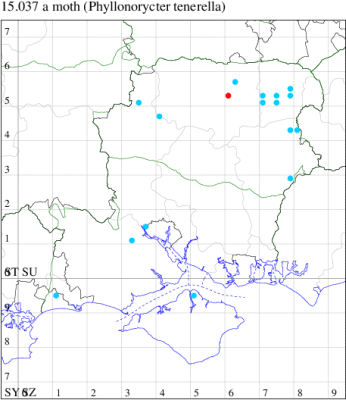
Records by year
Records by week (adult)
Records by week (larval)
Record Details
VC12: Basingstoke, vacated mine, present, on Hornbeam, 05 Sep (MJW)
15.039 [B&F: 0320] Phyllonorycter quercifoliella (Zeller, 1839) - Common
Common in oak woodland and areas with scattered oaks throughout much of the British Isles, except for the Northern Isles. In Hampshire and on the Isle of Wight widespread and locally common to abundant, but perhaps declining. Wingspan 7-9 mm. Similar to P messaniella, in which the basal streak barely reaches middle of wing, terminating well before the apices of the first pair of strigulae. In P quercifoliella the apical streak extends to almost two-thirds and terminates slightly beyond the apices of the first pair of strigulae (MBGBI Vol 2). Imago fairly regular at light, but more frequently recorded in the larval stage, when mines are relatively easy to find where they are present. Larva mines leaves of deciduous oaks Quercus, over-wintering as a pupa in a cocoon.
Records prior to 2021
| Vice County | #Records | #Individuals | First Record | Last Record |
|---|---|---|---|---|
| 10 | 78 | 32 | 1947 | 2020 |
| 11 | 127 | 108 | 1968 | 2020 |
| 12 | 87 | 93 | 1971 | 2020 |
2021 records
| Vice County | #Records | #Individuals | Max Quantity |
|---|---|---|---|
| 11 | 3 | 1 | 1 |
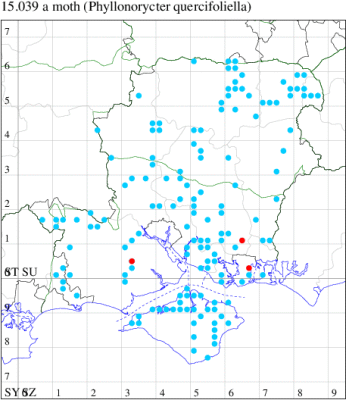
Records by year
Records by week (adult)
Records by week (larval)
Record Details
VC11: Denny Wood, NF, one, field observation, 19 May (DAS); Great Salterns NR, Portsmouth, mine, present, 30 Sep; Creech Woods, mine, present, 29 Sep (MRY, JRL)
15.040 [B&F: 0321] Phyllonorycter messaniella (Zeller, 1846) - Common
Common in woodland throughout much of the British Isles, more numerous in the south. Abundant in Hampshire and on the Isle of Wight. Wingspan 7-9 mm. Very similar to P quercifoliella, which see for differences. Although the imago is fairly regular at light, just as likely to be recorded in the larval stage, when mines are relatively easy to find where they are present. Larva mines leaves of Oak, especially Evergreen Oak, Hornbeam, Beech and Sweet Chestnut.
Records prior to 2021
| Vice County | #Records | #Individuals | First Record | Last Record |
|---|---|---|---|---|
| 10 | 237 | 847 | 1974 | 2020 |
| 11 | 1121 | 1387 | 1971 | 2020 |
| 12 | 78 | 44 | 1976 | 2020 |
2021 records
| Vice County | #Records | #Individuals | Max Quantity |
|---|---|---|---|
| 10 | 24 | 66 | 14 |
| 11 | 15 | 18 | 3 |
| 12 | 8 | 1 | 1 |
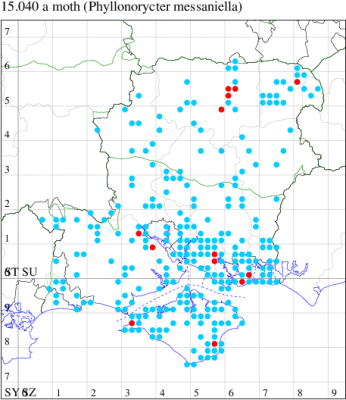
Records by year
Records by week (adult)
Records by week (larval)
Record Details
VC10: Totland, one, 21 Jul; one, 24 Jul; one, 27 Jul; one, 31 Aug; one, 01 Sep; six, 02 Sep; three, 04 Sep; six, 25 Sep; four, 26 Sep; two, 29 Sep; two, 01 Oct; 14, 22 Oct; one, 23 Oct; one, 24 Oct; seven, 19 Nov; one, 20 Nov (RTer); Freshwater, one, 20 Aug; three, 07 Oct; three, 10 Nov; one, 16 Nov (DCoo); Shanklin, one, examined, 25 Sep; one, 12 Oct; three, 09 Nov; one, 16 Nov (IOut);
VC11: Marchwood, one, 19 Sep (CTha); Totton, one, 27 Oct; one, 28 Oct (LHan); Fareham, three, 14 Oct; one, 11 Nov (IMcP); two, 18 Sep; one, 27 Oct; one, 08 Nov; one, 14 Nov (MLO); Portsmouth, one, 24 Oct; one, 14 Dec; one, 31 Dec (IRT); Southsea, one, 24 Sep; one, 27 Sep (JRL det. MRY); one, field observation, 27 Sep (MRY, JRL);
VC12: South Wood, Kempshott, mine, present, on Beech, 05 Sep; Pardown Copse, Oakley, mine, present, on Beech, 05 Sep; Kempshott, Basingstoke, mine, present, on Beech, 05 Sep; mine, present, on Beech, 05 Sep; Rooksdown, Basingstoke, vacated mine, present, on Beech, 05 Sep; mine, present, 19 Aug; vacated mine, present, on Fagus, 05 Sep (MJW); Minley Wood, one, field observation, 24 Oct (BDal)
15.041 [B&F: 0321a] Phyllonorycter platani (Staudinger, 1870) - Local
Local in parks and urban areas, discovered new to Britain in London in 1990, since when it has spread through the southern counties of the UK and has reached the West Country and Midlands. Found in Hampshire for the first time in 1998 in Southampton and on the Isle of Wight in 2004, becoming more frequent and widespread. Wingspan 9-10.5 mm. Imago seldom encountered at light, and more likely to be recorded in the larval stage, when mines are relatively easy to find where they are present. Larva mines leaves of London Plane in late autumn and are large and obvious, one leaf often hosting several, over-wintering as a pupa in a cocoon.
Records prior to 2021
| Vice County | #Records | #Individuals | First Record | Last Record |
|---|---|---|---|---|
| 10 | 31 | 324 | 2004 | 2020 |
| 11 | 95 | 1864 | 1998 | 2020 |
| 12 | 18 | 55 | 2002 | 2020 |
2021 records
| Vice County | #Records | #Individuals | Max Quantity |
|---|---|---|---|
| 11 | 1 | 100 | 100 |
| 12 | 4 | 87 | 41 |
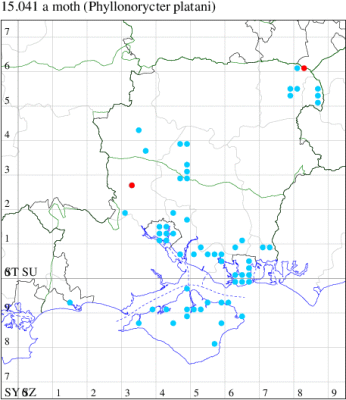
Records by year
Records by week (adult)
Records by week (larval)
Record Details
VC11: Mottisfont Abbey, mine, 100, mines on both species of Plane, though more numerous on London Plane; mines were found widely, but leaves in multiple occupancy were the exception, 21 Oct (RJD);
VC12: Frogmore, mine, one, 16 Jul; mine, 13, 05 Oct; mine, 41, 18 Oct; mine, 32, 21 Oct (BDal)
15.043 [B&F: 0323] Phyllonorycter oxyacanthae (Frey, 1856) - Common
Common in hedgerows and woodland throughout much of the British Isles. Abundant in Hampshire and on the Isle of Wight. Wingspan 6-8 mm. This species, P. sorbi and P. mespilella cannot be separated on the basis of wing characteristics alone, however, P. sorbi, is generally larger and most specimens of P. mespilella lack the white patch on the dorsum beneath the basal streak (MBGBI Vol 2). Imago fairly regular at light, but more frequently recorded in the larval stage, when mines are relatively easy to find where they are present. Larva mines leaves of Hawthorn, Pear and Quince, over-wintering as a pupa in a cocoon.
Records prior to 2021
| Vice County | #Records | #Individuals | First Record | Last Record |
|---|---|---|---|---|
| 10 | 75 | 30 | 1926 | 2020 |
| 11 | 353 | 276 | 1969 | 2020 |
| 12 | 107 | 49 | 1975 | 2020 |
2021 records
| Vice County | #Records | #Individuals | Max Quantity |
|---|---|---|---|
| 11 | 1 | 0 | 0 |
| 12 | 3 | 1 | 1 |

Records by year
Records by week (adult)
Records by week (larval)
Record Details
VC11: Botley Wood, mine, present, mine(s) on hawthorn, 15 Aug (DWal);
VC12: Crawley, one, 15 May (GCE); Basingstoke, mine, present, on Crataegus, 04 Sep; mine, present, on Crateagus, 24 Sep (MJW)
15.046 [B&F: 0326] Phyllonorycter blancardella (Fabricius, 1781) - Common
Common in woodland, orchards and gardens in southern England and Wales, rare elsewhere in the British Isles. Probably under-recorded in Hampshire and on the Isle of Wight, where the extent of known records correlate with those areas in which the recording effort is concentrated. Wingspan 6-8.5 mm. Similar to P. hostis, from which only reliably separated by dissection of the genitalia. Imago fairly regular at light, but more frequently recorded in the larval stage, when mines are relatively easy to find where they are present. Larva mines leaves of Crab Apple and Apple, over-wintering as a pupa in a cocoon.
Records prior to 2021
| Vice County | #Records | #Individuals | First Record | Last Record |
|---|---|---|---|---|
| 10 | 34 | 36 | 1926 | 2020 |
| 11 | 90 | 65 | 1969 | 2018 |
| 12 | 25 | 22 | 1994 | 2018 |
2021 records
| Vice County | #Records | #Individuals | Max Quantity |
|---|---|---|---|
| 10 | 1 | 1 | 1 |
| 11 | 1 | 1 | 1 |
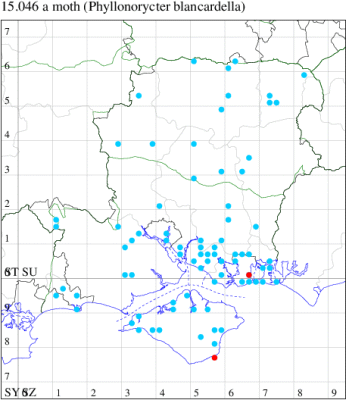
Records by year
Records by week (adult)
Records by week (larval)
Record Details
VC10: Bonchurch, one, field observation, specimen from James Halsey: gen det, narrow valvae, long right costa with long spine, short left costa with short spine, 16 Sep (IOut);
VC11: Portsmouth, one, 02 Jul (IRT)
15.050 [B&F: 0330] Phyllonorycter cerasicolella (Herrich-Schäffer, 1855) - Local
Local in woodland and orchards throughout southern England, north to Yorkshire. In Hampshire and on the Isle of Wight widely distributed, but not particularly common. Wingspan 7-8 mm. Cannot be distinguished on external characteristics from P. spinicolella. Imago seldom encountered at light, and more likely to be recorded in the larval stage, when mines are relatively easy to find where they are present. Larva mines leaves of Wild Cherry and Dwarf Cherry.
Records prior to 2021
| Vice County | #Records | #Individuals | First Record | Last Record |
|---|---|---|---|---|
| 10 | 14 | 14 | 1977 | 2020 |
| 11 | 50 | 20 | 1981 | 2018 |
| 12 | 15 | 19 | 1995 | 2011 |
2021 records
| Vice County | #Records | #Individuals | Max Quantity |
|---|---|---|---|
| 10 | 1 | 1 | 1 |
| 11 | 1 | 1 | 1 |
| 12 | 1 | 0 | 0 |
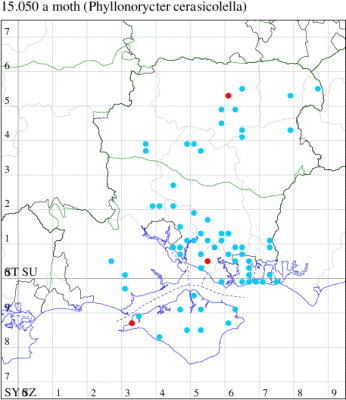
Records by year
Records by week (adult)
Records by week (larval)
Record Details
VC10: Totland, one, 22 Jul (RTer);
VC11: Stubbington, mine, one, mine on cherry, 29 Aug (DPH);
VC12: Rooksdown, Basingstoke, mine, present, on Prunus spinosa, 21 Sep (MJW)
15.051 [B&F: 0331] Phyllonorycter lantanella (Schrank, 1802) - Local
Local in hedgerows and open woodland, on calcareous soils, south of a line from the Severn estuary to The Wash. In Hampshire and on the Isle of Wight frequent on the chalk. Wingspan 8-9 mm. Adult can be separated from other Phyllonorycter species on external features only with great care, and most frequently recorded as leaf mine. Larva mines leaves of Wayfaring-tree and Guelder-rose.
Records prior to 2021
| Vice County | #Records | #Individuals | First Record | Last Record |
|---|---|---|---|---|
| 10 | 56 | 40 | 1900 | 2020 |
| 11 | 68 | 88 | 1973 | 2019 |
| 12 | 40 | 22 | 1975 | 2020 |
2021 records
| Vice County | #Records | #Individuals | Max Quantity |
|---|---|---|---|
| 11 | 2 | 16 | 15 |
| 12 | 3 | 1 | 1 |
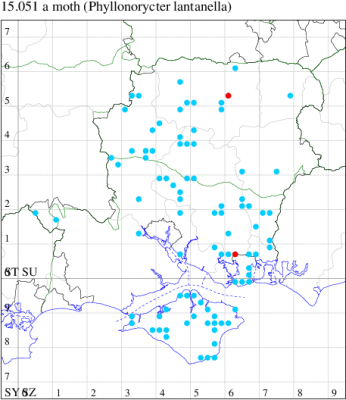
Records by year
Records by week (adult)
Records by week (larval)
Record Details
VC11: Botley Wood, mine, one, mine on Guelder Rose, 15 Aug (DWal); Portchester Common SSSI, mine, 15, 20 Sep (RJD);
VC12: Basingstoke, vacated mine, one, on Wayfaring-tree, 05 Sep; Rooksdown, Basingstoke, mine, present, 19 Aug; #N/A
15.052 [B&F: 0332] Phyllonorycter corylifoliella (Hübner, 1796) - Common
Common in scrubland, hedgerows and open woodland throughout much of the British Isles. Abundant in Hampshire and on the Isle of Wight. Wingspan 8-9 mm. Not often recorded at light, and more frequently recorded in the larval stage, when mines are relatively easy to find where they are present. Larva mines leaves of Hawthorn, Apple, Rowan, Cotoneaster and Birch, over-wintering as a pupa in a cocoon.
Records prior to 2021
| Vice County | #Records | #Individuals | First Record | Last Record |
|---|---|---|---|---|
| 10 | 123 | 46 | 1900 | 2020 |
| 11 | 423 | 377 | 1969 | 2020 |
| 12 | 120 | 31 | 1971 | 2020 |
2021 records
| Vice County | #Records | #Individuals | Max Quantity |
|---|---|---|---|
| 10 | 2 | 2 | 1 |
| 11 | 2 | 2 | 1 |
| 12 | 7 | 4 | 4 |
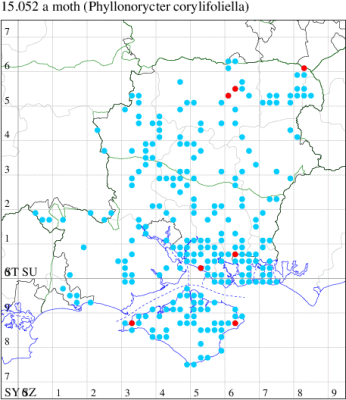
Records by year
Records by week (adult)
Records by week (larval)
Record Details
VC10: #N/ABembridge Marsh, mine, one, blotch mine on upper surface of Crataegus mongyna, 11 Jul (PBar);
VC11: Brownwich cliffs, mine, one, on rowan, 16 Aug (DWal); Portchester Common SSSI, mine, one, tenanted mine on upperside of hawthorn leaf, 20 Sep (RJD);
VC12: Rooksdown, Basingstoke, mine, present, on Crataegus, 21 Sep; mine, present, on Crateagus, 21 Sep; Basingstoke, mine, present, on Sorbus aria, 23 Sep; mine, present, on Crateagus, 24 Sep; Sherborne St John, vacated mine, present, on Crataegus, 29 Aug; Rooksdown, Basingstoke, mine, present, on Crateagus, 05 Sep (MJW); Frogmore, mine, four, 04 Nov (BDal)
15.053 [B&F: 0332a] Firethorn Leaf Miner Phyllonorycter leucographella (Zeller, 1850) - Common
Common in gardens, woodland and parkland throughout much of Britain. Thoroughly naturalised, through accidental introduction in garden plants, the first British record of this adventive species was in Essex in 1989, since when it has spread rapidly northwards to Yorkshire. It was first discovered in Hampshire in early 1998, but probably under-recorded in the county and on the Isle of Wight, where the extent of known records correlate with those areas in which the recording effort is concentrated. Wingspan 6.5-8.5 mm. Imago fairly regular at light, but just as likely to be recorded in the larval stage, when mines are relatively easy to find where they are present. Larva mines leaves of Firethorn, Hawthorn, Apple, Rowan and Whitebeam.
Records prior to 2021
| Vice County | #Records | #Individuals | First Record | Last Record |
|---|---|---|---|---|
| 10 | 79 | 202 | 2001 | 2020 |
| 11 | 378 | 436 | 1998 | 2020 |
| 12 | 118 | 1148 | 1998 | 2020 |
2021 records
| Vice County | #Records | #Individuals | Max Quantity |
|---|---|---|---|
| 10 | 5 | 6 | 2 |
| 11 | 6 | 6 | 2 |
| 12 | 19 | 17 | 10 |
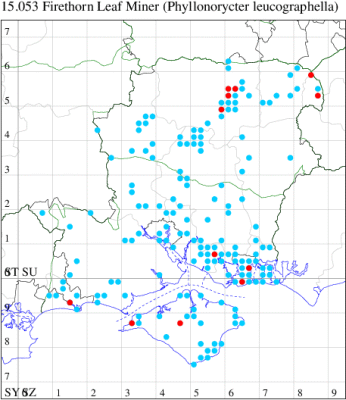
Records by year
Records by week (adult)
Records by week (larval)
Record Details
VC10: Totland, one, 31 Aug; two, 01 Oct (RTer); Freshwater, one, 18 Sep; one, 08 Oct (DCoo); Plaish, Carisbrooke, mine, one, on pyracantha, 24 Jul (KRyl);
VC11: Fareham, mine, two, mines on crab-apple, 03 Sep (RJD); Great Salterns NR, Portsmouth, mine, present, 30 Sep (MRY, JRL); Tuckton, Christchurch, one, 12 Jun; one, 14 Jun; one, 16 Sep (APar); Southsea, one, 07 Jun (JRL det. IRT);
VC12: South Wood, Kempshott, mine, present, on Crataegus, 05 Sep; Pardown Copse, Oakley, mine, present, on Crataegus, 05 Sep; Kempshott, Basingstoke, mine, present, on Crataegus, 05 Sep; mine, present, on Crataegus, 05 Sep (MJW); Kempshott, one, 07 Oct; two, 16 Oct (GAH); Rooksdown, Basingstoke, mine, present, on Crataegus, 21 Sep; Basingstoke, vacated mine, present, on Hornbeam, 05 Sep; mine, present, 24 Feb; mine, present, many tenanted mines on pyracantha and Crataegus, 15 Aug; mine, present, mines on Pyracantha and Wild Service-tree, 21 Aug; Rooksdown, Basingstoke, vacated mine, present, on Crataegus, 05 Sep; mine, present, on Crataegus, 19 Aug; Sherborne St John, mine, present, on Malus domestica, 29 Aug; Rooksdown, Basingstoke, mine, present, on Crataegus, 05 Sep (MJW); Blackwater, larva, two, field observation, 24 Feb; one, 08 Oct; mine, 10, on Pyracantha, 27 Dec (BDal); Farnborough, one, 11 Sep (KBW)
15.054 [B&F: 0333] Phyllonorycter salictella (Zeller, 1846) - Common
Common in marshes, river-banks and other damp areas in England and Wales, with scattered records in Scotland; rare in Ireland. In Hampshire and on the Isle of Wight locally common in the south-east of the county and around Fleet, and probably under-recorded elsewhere. Wingspan 7.5-8 mm. Imago fairly regular at light, but more frequently recorded in the larval stage, when mines are relatively easy to find where they are present. Larva mines leaves of smooth-leaved Salix species, such as Osier and Crack Willow, has also been recorded on Aspen, over-wintering as a pupa in a cocoon.
Records prior to 2021
| Vice County | #Records | #Individuals | First Record | Last Record |
|---|---|---|---|---|
| 10 | 17 | 6 | 1900 | 2013 |
| 11 | 141 | 74 | 1968 | 2020 |
| 12 | 26 | 9 | 1980 | 2020 |
2021 records
| Vice County | #Records | #Individuals | Max Quantity |
|---|---|---|---|
| 11 | 1 | 0 | 0 |
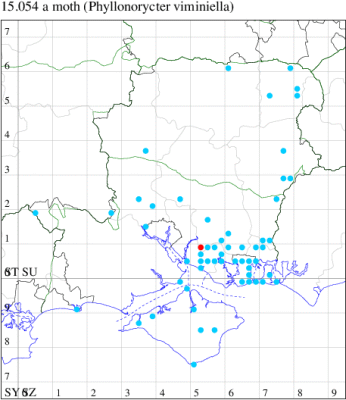
Records by year
Records by week (adult)
Records by week (larval)
Record Details
VC11: Botley Wood, mine, present, many mines on Salix, 14 Aug (DPH)
15.058 [B&F: 0337] Phyllonorycter hilarella (Zetterstedt, 1839) - Common
Common in woodland edges and woodland rides throughout the British Isles. In Hampshire and on the Isle of Wight a generally rather uncommon species. Wingspan 7-9 mm. Imago can be separated from several very similar Phyllonorycter species only by dissection of the genitalia, and much more frequently recorded in the larval stage, when mines are relatively easy to find where they are present. Larva mines leaves of Goat Willow, over-wintering as a pupa in a cocoon.
Records prior to 2021
| Vice County | #Records | #Individuals | First Record | Last Record |
|---|---|---|---|---|
| 10 | 9 | 13 | 1972 | 2013 |
| 11 | 19 | 10 | 1973 | 2020 |
| 12 | 19 | 13 | 1974 | 2020 |
2021 records
| Vice County | #Records | #Individuals | Max Quantity |
|---|---|---|---|
| 11 | 1 | 0 | 0 |
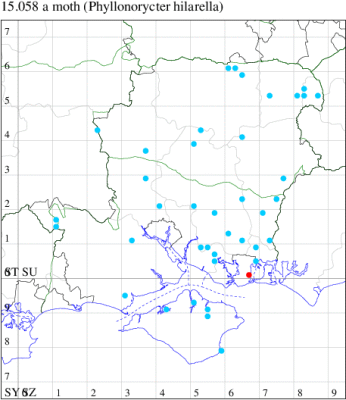
Records by year
Records by week (adult)
Records by week (larval)
Record Details
VC11: Milton Common, mine, present, 28 Sep (MRY, JRL)
15.061 [B&F: 0340] Phyllonorycter scopariella (Zeller, 1846) - Nationally Scarce B
Nationally scarce (Nb) on heathland and in open woodland throughout much of the British Isles, but difficult to locate either as an adult or in the larval stage. In Hampshire found at just a few sites in the north and south, but likely to be far more widely distributed than the records suggest. Not recorded from the Isle of Wight to date. Wingspan 6-8 mm. According to MBGBI Vol 2, it is seldom encountered except as an adult, however the majority of records in Hampshire are in the larval stage. Larva mines twigs of Broom.
Records prior to 2021
| Vice County | #Records | #Individuals | First Record | Last Record |
|---|---|---|---|---|
| 11 | 4 | 4 | 1974 | 2018 |
| 12 | 7 | 8 | 1976 | 2020 |
2021 records
| Vice County | #Records | #Individuals | Max Quantity |
|---|---|---|---|
| 12 | 1 | 0 | 0 |
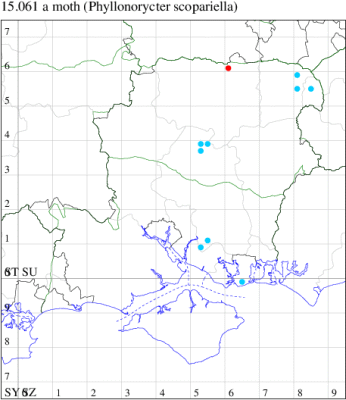
Records by year
Records by week (adult)
Records by week (larval)
Record Details
VC12: Pamber Forest, vacated mine, present, 3 mines on broom twigs in a 10 minute search, 02 Jan (GJD)
15.063 [B&F: 0341] Phyllonorycter maestingella (Müller, 1764) - Common
Common in deciduous woodland throughout the British Isles. Widespread and common in Hampshire and on the Isle of Wight, wherever there is Beech. Wingspan 7.5-9 mm. More frequently recorded in the larval stage, when the mines are often easy to find in suitable habitat; the imago can be separated from other similar Phyllonorycter species only by dissection of the genitalia. Larva mines leaves of Beech, over-wintering as a pupa in a cocoon.
Records prior to 2021
| Vice County | #Records | #Individuals | First Record | Last Record |
|---|---|---|---|---|
| 10 | 69 | 42 | 1949 | 2020 |
| 11 | 348 | 627 | 1972 | 2020 |
| 12 | 144 | 46 | 1973 | 2020 |
2021 records
| Vice County | #Records | #Individuals | Max Quantity |
|---|---|---|---|
| 11 | 4 | 12 | 10 |
| 12 | 7 | 0 | 0 |
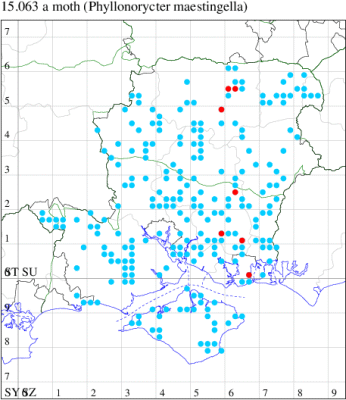
Records by year
Records by week (adult)
Records by week (larval)
Record Details
VC11: West Walk, Wickham, mine, 10, 10+ mines on beech leaves (undersides), 15 Nov; Portsmouth, one, 06 Sep (IRT); Creech Woods, mine, present, 29 Sep (MRY, JRL); West Meon, one, gen det, 07 May (RJD, MLO, ADT, DWal det. RJD);
VC12: South Wood, Kempshott, mine, present, on Beech, 05 Sep; Pardown Copse, Oakley, mine, present, on Beech, 05 Sep; Kempshott, Basingstoke, mine, present, on Beech, 05 Sep; mine, present, on Beech, 05 Sep; Rooksdown, Basingstoke, vacated mine, present, on Beech, 05 Sep; vacated mine, present, on Fagus, 05 Sep; #N/A
15.064 [B&F: 0342] Nut Leaf Blister Moth Phyllonorycter coryli (Nicelli, 1851) - Common
Very common in woodland, scrub and hedgerows throughout much of the British Isles, except for the Northern Isles. In Hampshire and on the Isle of Wight abundant wherever hazel occurs (it likely occurs in virtually every 1-km square in the county where hazel grows). The mine is one of the most easily found in the autumn countryside, forming a silvery, upper-side blotch, crossing veins and there may be multiple on the same leaf. The mine may contract later to cause leaf to fold upwards. The adult moth, like many Phyllonorycter species, is less distinctive and unless bred from a mine, records will require dissection for acceptance: given the ease of identification at the larval stage, this is probably not worthwhile.
Records prior to 2021
| Vice County | #Records | #Individuals | First Record | Last Record |
|---|---|---|---|---|
| 10 | 183 | 382 | 1950 | 2020 |
| 11 | 373 | 1184 | 1969 | 2020 |
| 12 | 188 | 28 | 1971 | 2020 |
2021 records
| Vice County | #Records | #Individuals | Max Quantity |
|---|---|---|---|
| 10 | 3 | 0 | 0 |
| 11 | 4 | 16 | 10 |
| 12 | 10 | 18 | 14 |
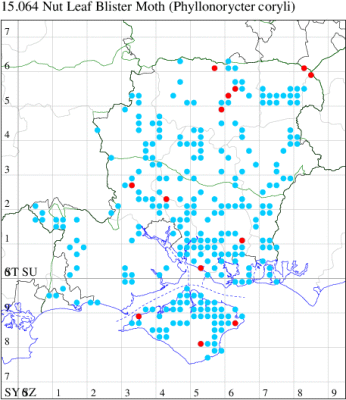
Records by year
Records by week (adult)
Records by week (larval)
Record Details
VC10: #N/ABeech Copse, Shanklin, mine, present, numerous vacated mines in Corylus avellana, 10 Nov (IOut); Bembridge Marsh, mine, present, blotch mines on upper surface of Corylus avellana leaves, 11 Jul (PBar);
VC11: Mottisfont Abbey, mine, 10, several mines in varying degrees of development on hazel uppersides, 21 Oct (RJD); Hocombe Mead LNR, Chandlers Ford, mine, six, 15 Sep (AMur); Thatcher's Copse, mine, present, on hazel, 16 Aug (DWal); Creech Woods, mine, present, 29 Sep (MRY, JRL);
VC12: South Wood, Kempshott, mine, present, on Hazel, 05 Sep; Pardown Copse, Oakley, mine, present, on Hazel, 05 Sep; Kempshott, Basingstoke, mine, present, on Hazel, 05 Sep; mine, present, on Hazel, 05 Sep (MJW); Great Haughurst Copse, Axmansford, mine, present, many blotch mines on hazel leaves, 17 Sep (ACB, MJW det. MJW); Winklebury, Basingstoke, vacated mine, present, on Corylus, 05 Sep; Sherborne St John, mine, present, on Corylus, 29 Aug; Rooksdown, Basingstoke, mine, present, on Corylus, 05 Sep (MJW); Hawley Meadows, mine, 14, 05 Oct; Frogmore, mine, four, on Corylus, 07 Oct (BDal)
15.065 [B&F: 0343] Phyllonorycter esperella (Goeze, 1783) - Local
Local in woodland in south-east England up to Northamptonshire, with isolated records elsewhere from the south-west and Welsh borders (MBGBI Vol 2). Probably under-recorded in Hampshire, where the extent of known records correlate with those areas in which the recording effort is concentrated, with the first record from the Isle of Wight coming in 1996. Wingspan 7.5-9 mm. Imago not often seen at light, and more frequently recorded in the larval stage, when mines are relatively easy to find where they are present; in Hampshire and on the Island, almost all records are of the leaf mines, hence the sparseness of the flight-time graph. Larva mines leaves of Hornbeam, over-wintering as a pupa in a cocoon.
Records prior to 2021
| Vice County | #Records | #Individuals | First Record | Last Record |
|---|---|---|---|---|
| 10 | 24 | 7 | 1996 | 2020 |
| 11 | 48 | 38 | 1975 | 2019 |
| 12 | 36 | 62 | 1989 | 2020 |
2021 records
| Vice County | #Records | #Individuals | Max Quantity |
|---|---|---|---|
| 11 | 3 | 31 | 30 |
| 12 | 3 | 29 | 28 |
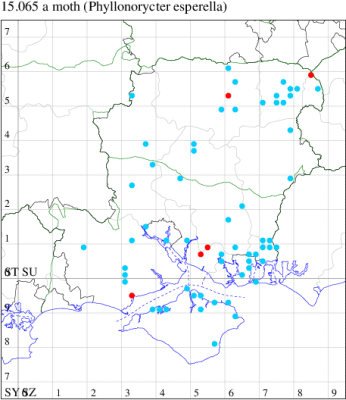
Records by year
Records by week (adult)
Records by week (larval)
Record Details
VC11: Titchfield Common, mine, 30, 30+ mines on Hornbeam, 02 Nov; Botley Wood, vacated mine, one, vacated mine on Hornbeam, 19 Nov (DPH); Lymington, mine, present, upperside blotch mines on leaves of Carpinus betulus, 23 Jun (PBar);
VC12: Rooksdown, Basingstoke, present, field observation, on Carpinus betulus, 23 Sep (MJW); Blackwater, mine, one, on Carpinus betulus, 07 Oct; mine, 28, 10 Oct (BDal)
15.067 [B&F: 0345] Phyllonorycter rajella (Linnaeus, 1758) - Common
Common in damp woodland throughout much of the British Isles. In Hampshire and on the Isle of Wight apparently well-distributed, but like many leaf miners, probably under-recorded in north Hampshire away from the M3 corridor, and in the New Forest. Wingspan 7-9 mm. Imago does not readily come to light, and more frequently recorded in the larval stage, when mines are relatively easy to find where they are present. Larva mines leaves of Alder and Italian Alder, over-wintering as a pupa in a cocoon.
Records prior to 2021
| Vice County | #Records | #Individuals | First Record | Last Record |
|---|---|---|---|---|
| 10 | 37 | 13 | 1937 | 2016 |
| 11 | 113 | 36 | 1973 | 2020 |
| 12 | 60 | 8 | 1981 | 2020 |
2021 records
| Vice County | #Records | #Individuals | Max Quantity |
|---|---|---|---|
| 11 | 1 | 1 | 1 |
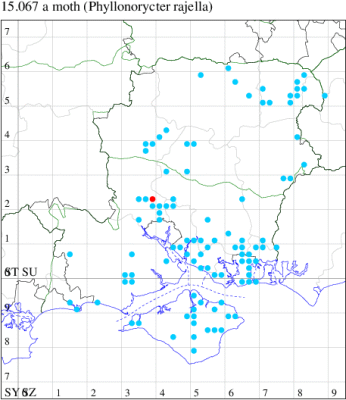
Records by year
Records by week (adult)
Records by week (larval)
Record Details
VC11: Romsey, one, 15 Jul (NRJ)
15.073 [B&F: 0351] Phyllonorycter lautella (Zeller, 1846) - Local
Local in woodland and areas with scattered oaks throughout much of the British Isles. In Hampshire and on the Isle of Wight widespread and locally common, but perhaps under-recorded in the north of the county away from the M3 corridor. Wingspan 6-7 mm. Larva mines leaves of Oak, preferring the foliage of saplings and stooled oaks, over-wintering as a pupa in a cocoon.
Records prior to 2021
| Vice County | #Records | #Individuals | First Record | Last Record |
|---|---|---|---|---|
| 10 | 13 | 9 | 1900 | 2013 |
| 11 | 74 | 60 | 1974 | 2015 |
| 12 | 43 | 6 | 1958 | 2020 |
2021 records
| Vice County | #Records | #Individuals | Max Quantity |
|---|---|---|---|
| 11 | 1 | 20 | 20 |
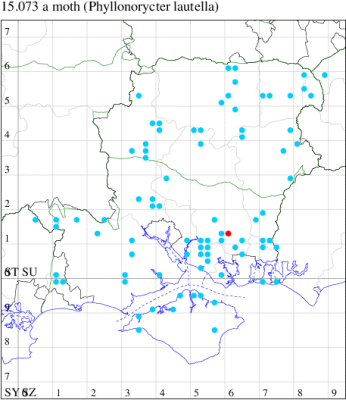
Records by year
Records by week (adult)
Records by week (larval)
Record Details
VC11: West Walk, mine, 20, about twenty mines on a seedling oak, 01 Nov (RJD)
15.074 [B&F: 0352] Phyllonorycter schreberella (Fabricius, 1781) - Common
Common in hedgerows throughout much of England and Wales. Reasonably common in south-east Hampshire and on the Isle of Wight, but elsewhere in the county distinctly uncommon. Wingspan 6.5-7.5 mm. Almost always recorded in the larval stage, when the mines are fairly easy to find where they are present, the adult can be separated from other similar Phyllonorycter species on external features only with great care. Larva mines leaves of Elm, over-wintering as a pupa in a cocoon.
Records prior to 2021
| Vice County | #Records | #Individuals | First Record | Last Record |
|---|---|---|---|---|
| 10 | 52 | 40 | 1900 | 2020 |
| 11 | 65 | 14 | 1976 | 2019 |
| 12 | 30 | 9 | 1980 | 2020 |
2021 records
| Vice County | #Records | #Individuals | Max Quantity |
|---|---|---|---|
| 11 | 2 | 12 | 12 |
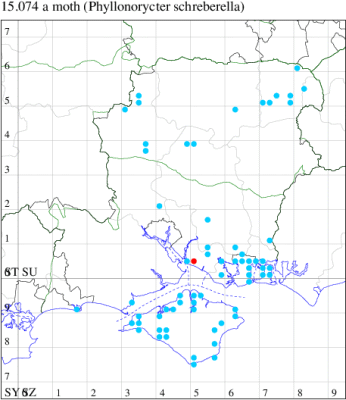
Records by year
Records by week (adult)
Records by week (larval)
Record Details
VC11: Chilling, mine, present, on Ulmus, 13 Aug (DWal); mine, 12, on Ulmus, 02 Nov (DPH)
15.075 [B&F: 0353] Phyllonorycter ulmifoliella (Hübner, [1817]) - Common
Widespread and common in birch woodland, with most records being of the leaf mine. Wingspan 7-9mm. Forewing golden-brown, with four costal and three dorsal white strigulae, dark edged inwardly, with a white dark-edged basal streak to one-third. The first pair of strigulae meet to form a slightly curved fascia; dorsal strigulae 2 and 3 lie between the remaining three costal marks, the second pair nearly meeting to form a second fascia, as can the third pair. Sometimes has a pale dorsal patch between the base and the first fascia.
The larva mines the underside of Birch leaves; a small mine, 8-14mm long, causing the upperside to appear dried-up and brownish, the underside with several folds which coalesce to give the appearance of a larger central fold. The leaf is often contorted and curves downwards. Mines can be found in June/July and more plentifully during autumn.
Records prior to 2021
| Vice County | #Records | #Individuals | First Record | Last Record |
|---|---|---|---|---|
| 10 | 35 | 40 | 1937 | 2018 |
| 11 | 271 | 116 | 1968 | 2020 |
| 12 | 92 | 50 | 1975 | 2020 |
2021 records
| Vice County | #Records | #Individuals | Max Quantity |
|---|---|---|---|
| 11 | 2 | 1 | 1 |
| 12 | 2 | 1 | 1 |
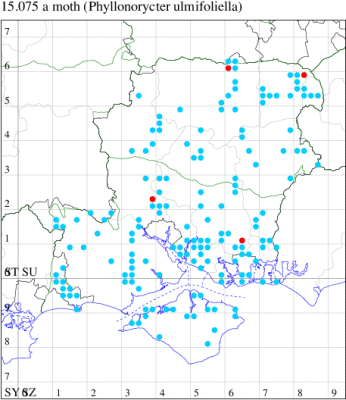
Records by year
Records by week (adult)
Records by week (larval)
Record Details
VC11: Romsey, one, 16 Jul (NRJ); Creech Woods, mine, present, 29 Sep (MRY, JRL);
VC12: Pamber Forest, vacated mine, present, common on birch saplings, 26 Sep (GJD); Yateley Common, mine, one, 17 Oct (BDal)
15.078 [B&F: 0356] Phyllonorycter tristrigella (Haworth, 1828) - Common
Common in hedgerows in England and Wales. In Hampshire mines are widespread and common on Elm in both vice-counties, and evidently also widespread on the Isle of Wight. Wingspan 7.5-8.5 mm. Imago differs from P. stettinensis, P. froelichiella, P. nicellii and P. kleemannella in having the white pattern much less metallic and its black edging fading more evenly into the ground colour. Imago seldom encountered at light, and more likely to be recorded in the larval stage, when mines are relatively easy to find where they are present. Larva mines leaves of Wych Elm, English Elm and Small-leaved Elm, over-wintering as a pupa in a cocoon.
Records prior to 2021
| Vice County | #Records | #Individuals | First Record | Last Record |
|---|---|---|---|---|
| 10 | 63 | 49 | 1977 | 2020 |
| 11 | 111 | 34 | 1972 | 2020 |
| 12 | 36 | 16 | 1993 | 2020 |
2021 records
| Vice County | #Records | #Individuals | Max Quantity |
|---|---|---|---|
| 11 | 3 | 2 | 1 |
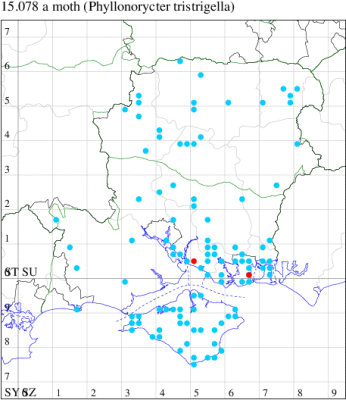
Records by year
Records by week (adult)
Records by week (larval)
Record Details
VC11: Chilling, mine, one, on Ulmus, 03 Aug (DWal); Milton Common, mine, present, 28 Sep (MRY, JRL); Portsmouth, one, 16 Jul (IRT)
15.081 [B&F: 0359] Phyllonorycter nicellii (Stainton, 1851) - Common
Common in woodland throughout much of the British Isles, but more plentiful in the south. In Hampshire and on the Isle of Wight widespread and common. Wingspan 7-8 mm. Imago similar to P. stettinensis, P. tristrigella, P. froelichiella and, especially, P. kleemannella. P. kleemannella and P. nicellii are two of the more difficult of the group to distinguish. P. kleemannella has a deeper orange ground colour, the fasciae are more shining and often bordered inwardly by a broad band of deep coppery brown rather than the brown irroration of P. nicellii; the first pair of strigulae rarely meet. In P. nicellii the first pair of strigulae often touch, forming a third angulated fascia (MBGBI Vol 2). Imago seldom encountered at light, and more likely to be recorded in the larval stage, when mines are relatively easy to find where they are present. Larva mines leaves of Hazel, over-wintering as a pupa in a cocoon.
Records prior to 2021
| Vice County | #Records | #Individuals | First Record | Last Record |
|---|---|---|---|---|
| 10 | 88 | 76 | 1926 | 2020 |
| 11 | 280 | 188 | 1969 | 2020 |
| 12 | 132 | 51 | 1971 | 2020 |
2021 records
| Vice County | #Records | #Individuals | Max Quantity |
|---|---|---|---|
| 10 | 1 | 1 | 1 |
| 11 | 7 | 8 | 2 |
| 12 | 3 | 4 | 3 |
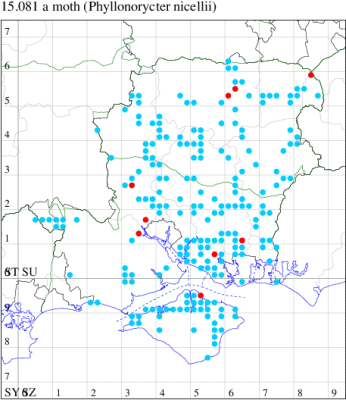
Records by year
Records by week (adult)
Records by week (larval)
Record Details
VC10: Osborne Valley Walk, one, 01 Jun (IOut);
VC11: Totton, one, field observation, 26 Apr; one, field observation, 25 Jul; two, field observation, 14 Aug (LHan); Lee, nr Nursling, one, 28 May (CTha); Mottisfont Abbey, mine, two, on hazel undersurface, 21 Oct (RJD); Fareham, vacated mine, one, mine on Hazel, 30 Aug (MLO); Creech Woods, mine, present, 29 Sep (MRY, JRL);
VC12: Basingstoke, mine, one, on Corylus, 13 Aug; Sherborne St John, mine, present, on Corylus, 29 Aug (MJW); Blackwater, mine, three, 14 Nov (BDal)
15.083 [B&F: 0361] Phyllonorycter trifasciella (Haworth, 1828) - Common
Common in woodland and hedgerows throughout England and Wales, more local in Scotland and apparently only coastal in Ireland (MBGBI Vol 2). In Hampshire and on the Isle of Wight common and widespread. Wingspan 7-8 mm. Imago fairly regular at light, but just as likely to be recorded in the larval stage, when mines are relatively easy to find where they are present. Larva mines leaves of Honeysuckle Lonicera periclymenum, but also Leycesteria formosa and Symphoricarpos.
Records prior to 2021
| Vice County | #Records | #Individuals | First Record | Last Record |
|---|---|---|---|---|
| 10 | 70 | 47 | 1900 | 2020 |
| 11 | 320 | 277 | 1972 | 2019 |
| 12 | 51 | 42 | 1974 | 2019 |
2021 records
| Vice County | #Records | #Individuals | Max Quantity |
|---|---|---|---|
| 10 | 5 | 6 | 2 |
| 11 | 3 | 6 | 4 |
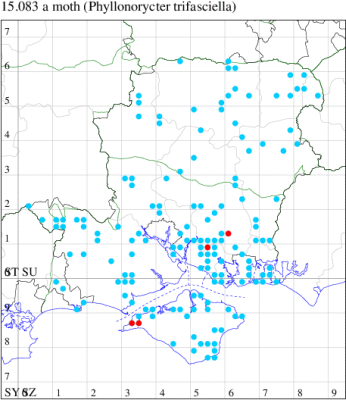
Records by year
Records by week (adult)
Records by week (larval)
Record Details
VC10: Totland, one, 25 Jul (RTer); Freshwater, two, 28 May; one, 09 Sep; one, 09 Nov (DCoo); Afton/Blackbridge area, mine, one, vacant mine on Snowberry, 27 Oct (SDav);
VC11: Botley Wood, mine, one, well-formed mine on honeysuckle, 22 Mar; mine, one, fully developed mine on honeysuckle, 19 Apr; West Walk, mine, four, 4 well-fed mines on honeysuckle, 08 Mar (RJD)
15.084 [B&F: 0362] Phyllonorycter acerifoliella (Zeller, 1839) - Common
Common in woodland and hedgerows in south Wales and England, as far north as Derbyshire, with isolated records in Northumberland and Westmorland (MBGBI Vol 2). In Hampshire and on the Isle of Wight common and fairly widespread. Wingspan 8 mm. Imago similar to P. platanoidella, in which the dorsal strigula forming part of the rudimentary first fascia does not nearly touch and make a straight fascia with the second costal strigula as in P. acerifoliella; the second fascia forms an obtuse angle or a smooth curve, whereas in P. acerifoliella it forms an acute or right angle; the yellow-brown coloration of the pattern is deeper than on P. acerifoliella (MBGBI Vol 2). Also similar to P. geniculella, which see for differences. Imago seldom encountered at light, and more likely to be recorded in the larval stage, when mines are relatively easy to find where they are present. Larva mines leaves of Field Maple, over-wintering as a pupa in a cocoon.
Records prior to 2021
| Vice County | #Records | #Individuals | First Record | Last Record |
|---|---|---|---|---|
| 10 | 70 | 31 | 1900 | 2020 |
| 11 | 200 | 113 | 1969 | 2020 |
| 12 | 71 | 16 | 1975 | 2020 |
2021 records
| Vice County | #Records | #Individuals | Max Quantity |
|---|---|---|---|
| 11 | 1 | 1 | 1 |
| 12 | 1 | 0 | 0 |
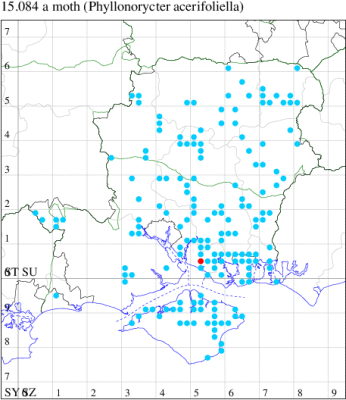
Records by year
Records by week (adult)
Records by week (larval)
Record Details
VC11: Abshott, mine, one, on Field Maple, 17 Aug (DWal);
VC12: Basingstoke, mine, present, on Acer, 18 Sep (MJW)
15.085 [B&F: 0363] Phyllonorycter joannisi (Le Marchand, 1936) - Common
Common in woodland and hedgerows throughout much of south-eastern England and in Worcestershire, but expanding northwards and has recently been found as far north as Yorkshire (MBGBI Vol 2, UKMoths). First discovered in Winchester (vice-county 11) in 1977, spreading to vice-county 12 at Leckford seven years later and the Isle of Wight (vice-county 10) in 2000. Now fairly widespread across both counties, although rare in the New Forest. Wingspan 8 mm. Imago similar to P. acerifoliella and P. geniculella. Imago only occasionally encountered at light, and more likely to be recorded in the larval stage, when mines are relatively easy to find where they are present. Larva monophagous, mining leaves of Norway Maple and over-wintering as a pupa in a cocoon.
Records prior to 2021
| Vice County | #Records | #Individuals | First Record | Last Record |
|---|---|---|---|---|
| 10 | 27 | 20 | 2000 | 2020 |
| 11 | 89 | 112 | 1980 | 2020 |
| 12 | 40 | 15 | 1985 | 2020 |
2021 records
| Vice County | #Records | #Individuals | Max Quantity |
|---|---|---|---|
| 12 | 2 | 2 | 1 |
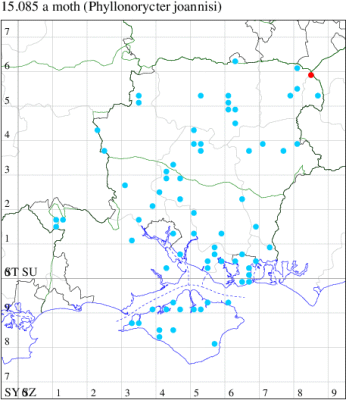
Records by year
Records by week (adult)
Records by week (larval)
Record Details
VC12: Blackwater, one, 09 Sep; one, 12 Sep (BDal)
15.086 [B&F: 0364] Phyllonorycter geniculella (Ragonot, 1874) - Common
Common in woodland and hedgerows throughout much of Britain, but not in northern Scotland. In Hampshire and on the Isle of Wight fairly well distributed, but perhaps under-recorded in north Hampshire away from the M3 corridor and in the New Forest. Wingspan 8 mm. Similar to P. acerifoliella and P. platanoidella, but differs in having the second chevron sharply angled with its apex extended as a dark-bordered yellow line to the third chevron; the rudimentary first chevron at the base of the wing contains more yellowish brown scales than either of the other two species (MBGBI Vol 2). Imago relatively uncommon at light, and more likely to be recorded in the larval stage, when mines are relatively easy to find where they are present. Larva mines leaves of Sycamore, over-wintering as a pupa in a cocoon.
Records prior to 2021
| Vice County | #Records | #Individuals | First Record | Last Record |
|---|---|---|---|---|
| 10 | 86 | 41 | 1959 | 2020 |
| 11 | 192 | 127 | 1972 | 2020 |
| 12 | 62 | 50 | 1980 | 2018 |
2021 records
| Vice County | #Records | #Individuals | Max Quantity |
|---|---|---|---|
| 11 | 1 | 1 | 1 |
| 12 | 1 | 0 | 0 |
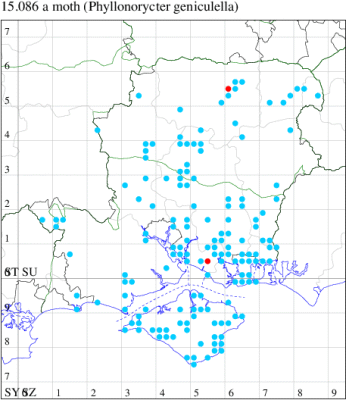
Records by year
Records by week (adult)
Records by week (larval)
Record Details
VC11: Stubbington, mine, one, mine on sycamore, 19 Aug (DPH);
VC12: Rooksdown, Basingstoke, vacated mine, present, on Sycamore, 05 Sep (MJW)
15.087 [B&F: 0365] Phyllonorycter comparella (Duponchel, [1843]) - Nationally Scarce A
Scarce in damp woodland throughout England. Wingspan 8 mm. Larva mines leaves of White Poplar and Grey Poplar, often favouring isolated, young saplings. In Hampshire first identified as a mine on poplar leaves at Butterwood near Hook, VC12 in 2007 (also reported from the Hants/Surrey border in 2021); subsequently found to be locally common in the Portsmouth area with records from 2019 to date. Not recorded from the Isle of Wight to date.
Records prior to 2021
| Vice County | #Records | #Individuals | First Record | Last Record |
|---|---|---|---|---|
| 11 | 5 | 3 | 2019 | 2019 |
| 12 | 1 | 5 | 2007 | 2007 |
2021 records
| Vice County | #Records | #Individuals | Max Quantity |
|---|---|---|---|
| 12 | 1 | 2 | 2 |
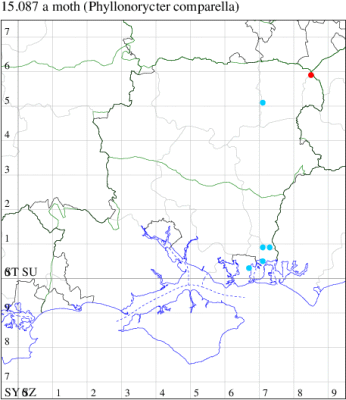
Records by year
Records by week (adult)
Records by week (larval)
Record Details
VC12: Hawley Meadows, mine, two, 05 Oct (BDal)
15.089 [B&F: 0366a] Cameraria ohridella Deschka & Dimic, 1986 - Common
Common in parks and urban areas throughout much of south-eastern England. An adventive species, first recorded in Europe in Macedonia in 1995, from where it has spread rapidly. In Britain, first recorded in Wimbledon, London in 2002, reaching plague proportions around Greater London and along the Thames Valley by 2006. The first record in Hampshire occurred in 2004, and it appears that it is being dispersed along railway lines and major roads, and now widespread and abundant across much of the county and on the Isle of Wight. Wingspan 8 mm. The larva mines the leaves of Horse Chestnut causing noticeable brown blotches, often many to one leaf, often resulting in complete defoliation of a tree, over-wintering as a pupa in a cocoon. There is however, a similar-looking fungus which can cause confusion.
Records prior to 2021
| Vice County | #Records | #Individuals | First Record | Last Record |
|---|---|---|---|---|
| 10 | 237 | 2694 | 2003 | 2020 |
| 11 | 1041 | 15052 | 2004 | 2020 |
| 12 | 602 | 3406 | 2004 | 2020 |
2021 records
| Vice County | #Records | #Individuals | Max Quantity |
|---|---|---|---|
| 10 | 8 | 15 | 5 |
| 11 | 19 | 1024 | 1000 |
| 12 | 29 | 1050 | 1000 |
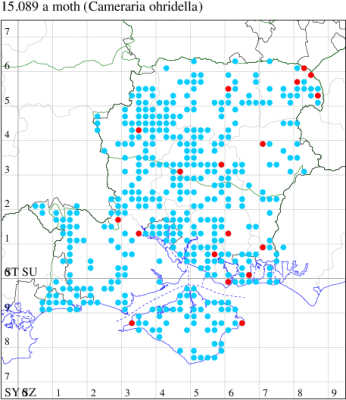
Records by year
Records by week (adult)
Records by week (larval)
Record Details
VC10: Totland Bay, four, field observation, 24 Jul (DCoo); Totland, one, 21 Jul; two, 24 Jul; five, 25 Jul; one, 02 Sep; one, 26 Sep (RTer); Freshwater, one, 17 Aug (DCoo); Bembridge, mine, present, 15 Aug (AEmm);
VC11: Totton, one, 18 Jul; one, 21 Jul; one, 31 Jul; one, 23 Aug; one, 26 Aug; one, 03 Sep; four, 07 Sep (LHan); Fareham, three, 27 Jul; one, 30 Jul; two, 09 Aug; one, 10 Aug; one, 25 Aug; one, 18 Sep (MLO); Portsmouth, one, 18 Jul; one, 19 Jul; two, 12 Sep (IRT); West Walk, one, 23 Jul (RJD, MLO, ADT, DWal, KJW); Staunton CP, mine, 1000, horse-chestnutes plastered with mine past counting, 10 Sep (RJD); Gosport, present, field observation, 25 Sep (ACBar);
VC12: Anna Valley, Andover, four, 14 Aug (TJN, LFom); Harestock, one, 20 Apr; one, 20 Jul; three, 27 Jul; seven, 01 Aug; one, 07 Aug; three, 11 Aug; two, 12 Aug; three, 14 Aug; one, 15 Aug; one, 18 Aug; one, 21 Aug; one, 08 Sep; one, 06 Oct; one, 09 Oct (GRog); New Alresford, mine, 1000, horse Chestnuts smothered with mines, 02 Sep (RJD); Rooksdown, Basingstoke, mine, present, on Sycamore, 05 Sep (MJW); Alton, one, field observation, 16 May (BCA); one, to artificial light, 09 Jun; one, to artificial light, 26 Jul (DBO); Minley Wood, mine, five, 22 Jun; mine, one, 24 Jun; Blackwater, one, at dusk, 09 May; one, 14 Aug; one, 12 Sep (BDal); Farnborough, two, 18 Jul; two, 22 Jul; two, 26 Jul (KBW); Frogmore, one, field observation, 09 Sep (BDal)
(Mine on Crateagus)(20210904_131557).jpg)
(Mine on Crateagus)(20210904_131601).jpg)
(Mine on Crateagus)(20210904_131625).jpg)
(Mine on Crateagus.jpg)
(20210829_171240).jpg)


(Mine on Wild Service Tree)(IMG_5873).jpg)

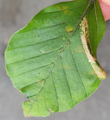
(Mine on Fagus)(20210905_092359).jpg)
(Mine on Fagus)(IMG_5796).jpg)
(Mine on Corylus)(20210905_100750).jpg)
(Mine on Corylus)(IMG_5649).jpg)
(mine on Corylus, underside)(IMG_5646).jpg)